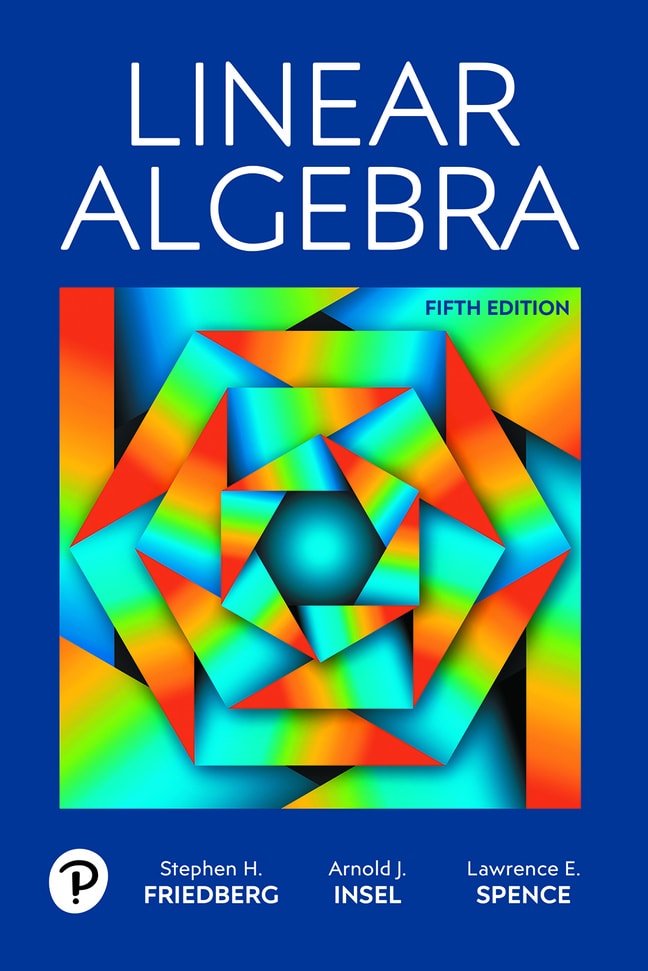
Linear Algebra, 5th edition
- Stephen H. Friedberg
- , Arnold J. Insel
- , Lawrence E. Spence

- Listen on the go
Learn how you like with full eTextbook audio
- Find it fast
Quickly navigate your eTextbook with search
- Stay organized
Access all your eTextbooks in one place
- Easily continue access
Keep learning with auto-renew
Linear Algebra presents a careful treatment of the principal topics of linear algebra. This acclaimed theorem-proof text emphasizes the symbiotic relationship between linear transformations and matrices, but states theorems in the more general infinite-dimensional case where appropriate. Applications to such areas as differential equations, economics, geometry and physics appear throughout. It is especially suited to a second course in linear algebra that emphasizes abstract vector spaces, and can be used in a first course with a strong theoretical emphasis. Updates to the 5th Edition include revised proofs of some theorems, additional examples, and new exercises. Also new in this revision are online solutions for selected theoretical exercises, accessible by short URLs at point-of-use.
Published by Pearson (July 14th 2021) - Copyright © 2019
ISBN-13: 9780137515424
Subject: Advanced Math
Category: Linear Algebra
- * Sections denoted by an asterisk are optional.
- Vector Spaces
- 1.1 Introduction
- 1.2 Vector Spaces
- 1.3 Subspaces
- 1.4 Linear Combinations and Systems of Linear Equations
- 1.5 Linear Dependence and Linear Independence
- 1.6 Bases and Dimension
- 1.7* Maximal Linearly Independent Subsets
- Index of Definitions
- Linear Transformations and Matrices
- 2.1 Linear Transformations, Null Spaces, and Ranges
- 2.2 The Matrix Representation of a Linear Transformation
- 2.3 Composition of Linear Transformations and Matrix Multiplication
- 2.4 Invertibility and Isomorphisms
- 2.5 The Change of Coordinate Matrix
- 2.6* Dual Spaces
- 2.7* Homogeneous Linear Differential Equations with Constant Coefficients
- Index of Definitions
- Elementary Matrix Operations and Systems of Linear Equations
- 3.1 Elementary Matrix Operations and Elementary Matrices
- 3.2 The Rank of a Matrix and Matrix Inverses
- 3.3 Systems of Linear Equations – Theoretical Aspects
- 3.4 Systems of Linear Equations – Computational Aspects
- Index of Definitions
- Determinants
- 4.1 Determinants of Order 2
- 4.2 Determinants of Order n
- 4.3 Properties of Determinants
- 4.4 Summary|Important Facts about Determinants
- 4.5* A Characterization of the Determinant
- Index of Definitions
- Diagonalization
- 5.1 Eigenvalues and Eigenvectors
- 5.2 Diagonalizability
- 5.3* Matrix Limits and Markov Chains
- 5.4 Invariant Subspaces and the Cayley–Hamilton Theorem
- Index of Definitions
- Inner Product Spaces
- 6.1 Inner Products and Norms
- 6.2 The Gram–Schmidt Orthogonalization Process and Orthogonal Complements
- 6.3 The Adjoint of a Linear Operator
- 6.4 Normal and Self-Adjoint Operators
- 6.5 Unitary and Orthogonal Operators and Their Matrices
- 6.6 Orthogonal Projections and the Spectral Theorem
- 6.7* The Singular Value Decomposition and the Pseudoinverse
- 6.8* Bilinear and Quadratic Forms
- 6.9* Einstein's Special Theory of Relativity
- 6.10* Conditioning and the Rayleigh Quotient
- 6.11* The Geometry of Orthogonal Operators
- Index of Definitions
- Canonical Forms
- 7.1 The Jordan Canonical Form I
- 7.2 The Jordan Canonical Form II
- 7.3 The Minimal Polynomial
- 7.4* The Rational Canonical Form
- Index of Definitions
Appendices
- A. Sets
- B. Functions
- C. Fields
- D. Complex Numbers
- E. Polynomials
Answers to Selected Exercises
Index